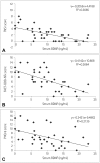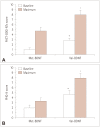Prediction of Chemotherapy-Induced Peripheral Neuropathy in Patients with Lymphoma and Myeloma: the Roles of Brain-Derived Neurotropic Factor Protein Levels and A Gene Polymorphism
- PMID: 31591840
- PMCID: PMC6785478
- DOI: 10.3988/jcn.2019.15.4.511
Prediction of Chemotherapy-Induced Peripheral Neuropathy in Patients with Lymphoma and Myeloma: the Roles of Brain-Derived Neurotropic Factor Protein Levels and A Gene Polymorphism
Abstract
Background and purpose: Brain-derived neurotrophic factor (BDNF) is a neuronal growth factor that plays an essential role in the maintenance of the nervous system. We have evaluated the peripheral blood protein levels of BDNF and the valine-to-methionine substitution at codon 66 (Val66Met) single-nucleotide polymorphism (SNP) as potential biomarkers for the early recognition of chemotherapy-induced peripheral neuropathy (CIPN) in non-Hodgkin lymphoma and multiple myeloma patients.
Methods: CIPN was assessed in 45 patients at the diagnosis and during vincristine or bortezomib-based therapy using objective [reduced version of the Total Neuropathy Score (TNSr)] and subjective (FACT-GOG-NTx) tools. Depression was assessed using the Patient Health Questionnaire-9 (PHQ-9) questionnaire. BDNF protein levels and the Val66Met SNP were determined using ELISA and Sanger sequencing.
Results: The pretreatment BDNF protein level was inversely correlated with the maximum TNSr, FACT-GOG-NTx, and PHQ-9 scores in both genotypes. BDNF patients with the Val/Val genotype demonstrated significantly higher maximum FACT-GOG-NTx and PHQ-9 scores than those with the Val/Met and Met/Met genotypes (Met-BNDF carriers). Correlations between PHQ-9 and TNSr score were found only in Met-BDNF carriers, suggesting that peripheral neuropathy and depression coincide in Met-BDNF carriers.
Conclusions: Determining the BDNF protein levels before initiating chemotherapy might be a useful tool for CIPN risk assessment and preemptive dose modification. The present data should be validated in larger studies that include other neurotoxic agents.
Keywords: BDNF; Val66Met single-nucleotide polymorphism; chemotherapy-induced peripheral neuropathy; multiple myeloma; non-Hodgkin lymphoma.
Copyright © 2019 Korean Neurological Association.
Conflict of interest statement
The authors have no potential conflicts of interest to disclose.
Figures


References
-
- Rocamora N, García-Ladona FJ, Palacios JM, Mengod G. Differential expression of brain-derived neurotrophic factor, neurotrophin-3, and low-affinity nerve growth factor receptor during the postnatal development of the rat cerebellar system. Brain Res Mol Brain Res. 1993;17:1–8. - PubMed
-
- Lipsky RH, Marini AM. Brain-derived neurotrophic factor in neuronal survival and behavior-related plasticity. Ann N Y Acad Sci. 2007;1122:130–143. - PubMed
-
- Novikova L, Novikov L, Kellerth JO. Brain-derived neurotrophic factor reduces necrotic zone and supports neuronal survival after spinal cord hemisection in adult rats. Neurosci Lett. 1996;220:203–206. - PubMed
-
- Egan MF, Kojima M, Callicott JH, Goldberg TE, Kolachana BS, Bertolino A, et al. The BDNF val66met polymorphism affects activitydependent secretion of BDNF and human memory and hippocampal function. Cell. 2003;112:257–269. - PubMed
-
- Białecka M, Kurzawski M, Roszmann A, Robowski P, Sitek EJ, Honczarenko K, et al. BDNF G196A (Val66Met) polymorphism associated with cognitive impairment in Parkinson's disease. Neurosci Lett. 2014;561:86–90. - PubMed
Grants and funding
LinkOut - more resources
Full Text Sources
Miscellaneous

